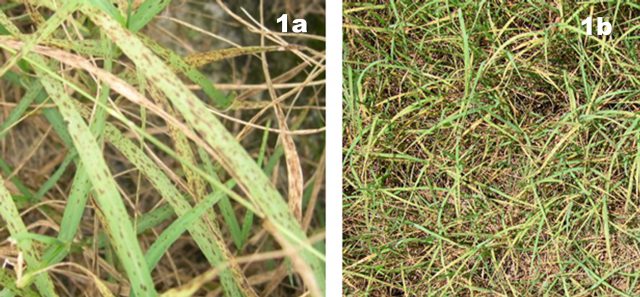
Fig. 1. Bipolaris infected bermudagrass. Moderate infection on bermudagrass leaves (1a) and in the stand (1b). Photo by Cheryl Mackowiak and Ann Blount
Cheryl Mackowiak, UF/IFAS Soil Fertility/Water Quality Specialist), Ann Blount, UF/IFAS Forage Breeding Specialist
With the hot, humid and rainy return of summer, livestock producers can expect forage leaf and root diseases outbreaks in pastures. Some of our most common forage diseases come from fungal organisms, but fungicides are rarely applied due to cost and label restrictions on livestock grazing. Grass forages can be attacked by foliar or soil-borne fungal diseases.
One of the most commonly identified foliar diseases in our summer pastures is leaf blight, also known as Bipolaris or Helminthosporium (Bipolaris cynodontis). It is often found in bermudagrass, star grass, and limpograsses, but not as much in bahiagrass. Early symptoms appear as dark brown specks that enlarge over time into irregular blotches or lesions as the disease progresses (Fig. 1 above). Grazing or mowing off the field (removes the fungal inoculant) helps to limit damage, but also reinforces the need to review your fertilizer practices. Low soil potassium and/or sulfur is quite often associated with these outbreaks.
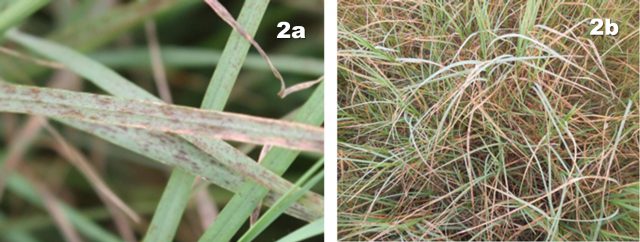
Fig. 2. Rust in bahiagrass. Rust pustules on individual leaves (2a) and in the stand (2b). Photo by Cheryl Mackowiak and Ann Blount
Leaf rust (Puccinia cynodontis) is a foliar fungal disease that attacks bermudagrass, star grass, and limpograss. This disease is most often observed from mid to late summer. The disease begins as small, dark brown to orange specks (pustules), similar in appearance to Bipolaris when observed from a distance (Fig. 2). However, if observed with a magnifying glass, you may notice that the pustules are raised above the leaf surface (Fig. 2). Sometimes they will leave an orange-brown residue (spores) on your fingers when you rub the leaves. Alicia and Jiggs bermudagrass tend to be more prone to rust. Grazing or cutting off the inoculant and managing for adequate potassium and sulfur soil fertility sometimes helps to minimize damage.
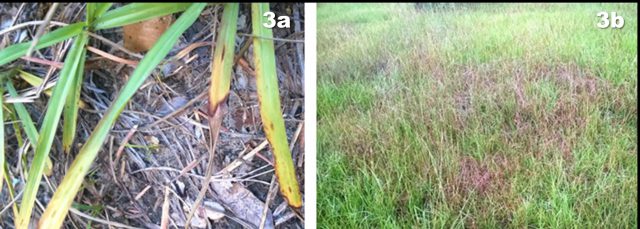
Fig. 3. Dollar Spot in bahiagrass. Infection of leaves (3a) and in a thinning stand (3b). Photo by Cheryl Mackowiak and Ann Blount
A common foliar fungal disease in bahiagrass is Dollar Spot (Sclerotinia homoeocarpa), but it is much less prevalent in the Argentine (wider leaf) variety. Pensacola, Tifton-9, Tif-Quik, and UF-Riata are examples of more susceptible varieties. The disease begins with dead and dying leaf blade tips and tan lesions further down the leaf blade (Fig. 3). Dollar spot can spread quickly under ideal conditions and it is not uncommon to lose large swaths or entire fields to the disease over several weeks, if it is not managed. Disease expression is strongest under moderate to warm temperatures, high humidity, soils that have been periodically dry, with excessive thatch residue. Deferred grazing or hay cuttings leading to rank growth that can also lead to outbreaks. Grazing or cutting to remove the inoculum may reduce disease spread and helps with recovery. Balanced soil fertility also helps.
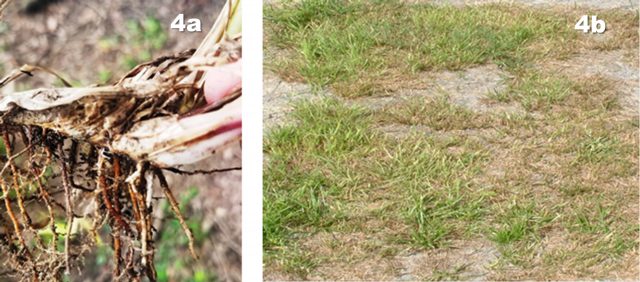
Fig. 4. Take-All disease in bahiagrass. Beginning of root die-back (Fig. 4a) and eventual stand loss (Fig. 4b). Photo by Cheryl Mackowiak and Ann Blount
There are several fungal root diseases that may infect our summer forage grasses. Early symptoms of an outbreak can appear as small to large circles of weak or dying forage (Fig. 4) or you might observe bright yellow leaves (looks like iron deficiency) in the case of bahiagrass (Fig. 5). Root fungal diseases identified by the UF-IFAS Plant Pathology Diagnostic lab in 2018 this far include Fusarium spp., Rhizoctonia spp., and Take-All (Gaeumannomyces graminis var. avenae), root rot type diseases. Take-All is particularly insidious because it may infect a field in the fall, near the time of plant dormancy and go unnoticed until the next spring or early summer, when the stand is already severely damaged. High pH soils (above 6.5) with low manganese fertility have sometimes been associated with Take-All outbreaks in turf grasses. Further study on the most damaging root rot diseases impacting forage grasses and management options to lessen their impact is needed.
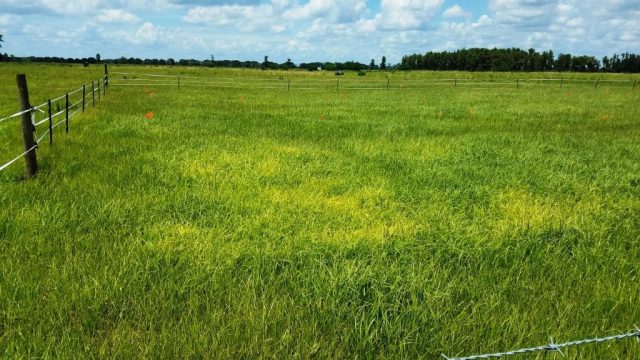
Fig. 5. Early symptoms of a root rot disease in bahiagrass in late summer. Sometimes the yellowing will not get worse and the stand will recover without further intervention. Photo by Cheryl Mackowiak and Ann Blount
There is good news! Forage producers can often lessen the occurrence and impact of pasture fungal diseases by managing for optimal soil fertility. Sampling soils every year or so and following the soil report fertilizer and liming recommendations is a good starting point. Additionally, by practicing good grazing management and not allowing hay fields to become overgrown will often limit fungal disease damage to tolerable levels. If you suspect a disease is behind your pasture or hay field decline, visit with your local county extension agent. They will help you determine where and how to sample for a disease diagnosis, if needed, and review your forage management to determine if there are other underlying factors resulting in poor stand health. Since some of these diseases can spread fast and kill your stand, you might not be able to wait for an extension visit. In those situations, take a few photos with your camera or phone (close-up of symptoms and field-scale), send them to your local county extension agent, and then cut or graze off the grass as soon as possible (within a day or two) to help reduce fungal inoculum and to lessen long-term impact.
- Grower Survey Insights on Cotton Nitrogen Management in Florida’s Panhandle - July 18, 2025
- 2025 Cool-Season Forage Tour – February 26 - February 14, 2025
- Florida Soils are an Indispensable Natural Resource - January 10, 2025
